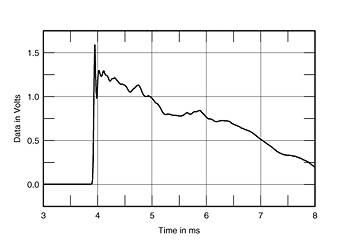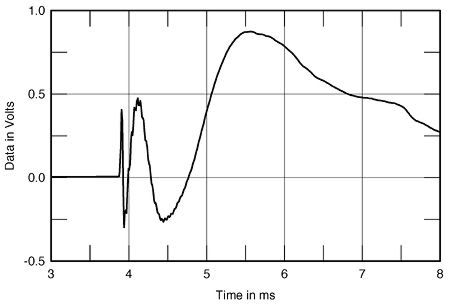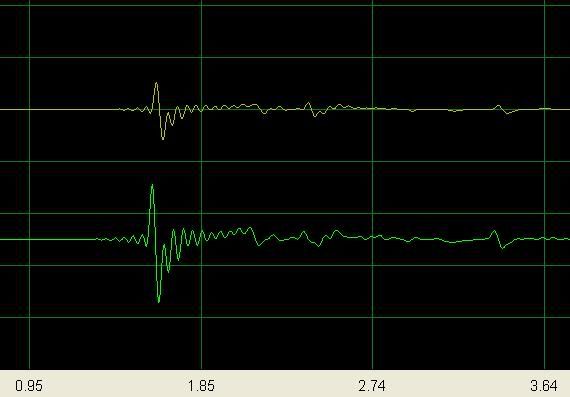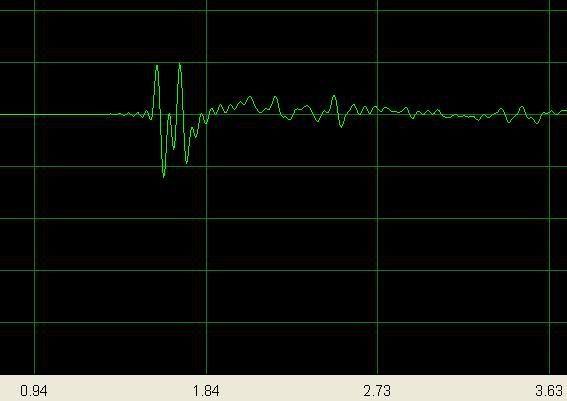Champ04
100+ Head-Fier
- Joined
- Jun 24, 2007
- Posts
- 147
- Likes
- 10
I've long been curious of all the various claims and arguments regarding cable audibility and jitter audibility. Recently I devised a little experiment whereby I could take a look into my own ability to "hear" these differences.
I would like to share my methods for this little experiment and get some quality feedback on it.
Let me respectfully request that all feedback be of a useful nature regardless of one's perspective. I dont care if you agree or not. Just make sure its useful. If you feel the need to rag on people who claim to hear differences in cables or if you want to disparage objectivists methods, please refrain from contributing.
That being said, here is what I did.................
I began with a pair of Scaena 3.2 speakers.
Scaena Homepage
These speakers are a line array design using 12 cone drivers aligned vertically immediately next to 9 ribbon type tweeters. Not including the seperate subwoofer they are a two way design.
The speakers use a 1st order crossover which means that there is inherently minimal phase error. Thus, with careful setup, I should be able to get a relatively good step response.
For those who may not know, a step response is a measurement that, among other things, is very useful for measuring the timing delay relative to the various drivers within a particular speaker.
Below is an example of a textbook step response. Sound from all drivers arrive at the ear at exactly the same time giving you a relatively nice right triangle graph.

Here is an example of a speaker that is not time aligned. Note how the three peaks show that the tweeter leads the midrange which also leads the woofer.

Any speaker with a verticle array of drivers must use either a stepped baffle or a tilted baffle in order to achieve time alignment of its drivers.
The Scaena is different in that the drivers are side by side. This allows me to effect the timing response by adjusting the relative toe in and toe out with respect to the listening position.
For the experiment I chose musical passages that I was very familiar with and also that contained instruments that I have experience playing, namely acoustic guitar and drums. So there was a very high degree of familiarity.
The actual experiement consisted of adjusting the toe in/toe out of the right channel while listening from a fixed and predetermined listening position. Both speakers began in the same horizontal plane relative to the listening position. Ie. same distance away. And both speakers were rotated around the same fixed spot being their inside front spike. I started from a point that was more or less 30 degrees toed out of what might be visually considered a position pointed directly at the listener. I started by toeing in the speaker a quarter of an inch at a time. After a handful of trials I narrowed the adjustment to an eigth of an inch and then eventually to a mear sixteenth of an inch adjustments.
With each trial I listened to the same track segments, listening first for the sustain in the cymbals and guitar strings and secondly for the exquisetly subjective notion of, "That sounds more like the real thing."
The idea being that a mismatch in timing between the drivers would result in cancelations in the musical waveform by the time it hit the ear and thus reduce the audibility of natural sustain and sense of space.
I went until I noticed the sound start to deteriorate from the previous trial. I went a few more trials beyond that point, just to be sure and then back to what I felt was the best subjective performance the speaker could achieve.
I anchored the speaker and moved on to the left channel.
On the left channel I took a calibrated measurement microphone and placed it in exactly the center of the listening position. Then I adjusted the toe in of the left channel as before, only this time I wasnt listening for anything. Rather I took measurements at each interval until I ended up with the best step response I could manage with the speakers.
Once I found the perfect spot for the left channel I left the microphone exactly where it was and measured the step response of the right channel. I also took various impulse responses of single speakers as well as the pair.
I also took careful physical measurements of each speakers placement relative to the listening position.
The results were quite suprising.
The physical placement of the speakers seem to end up with near identical mirror images of each other relative to the listening position. The down side was that there was a certain margin of error because I could not very well measure distance and sit in the position at the same time. But I took multiple measurements to try and be as accurate as possible. I feel comfortable in reporting that the two speakers were within a quarter inch, total, of their respective mirror images. I feel as though my knowledge of geometry is strong but it is quite difficult to define baseline points of space with good degrees of accuracy.
To try and get even greater precision measurements I used the impulse response of the test in order to try and accertain similarity.
Here is the resulting measurement using this method.
In it the top trace is the impulse response of right channel only. The bottom trace is of the stereo pair. Other than amplitude, they appear remarkably similar. In it you would expect the amplitude of the pair to be roughly twice that of a single speaker.

For reference, here is an example of the impulse response taken from a stereo pair where one speaker is at a slightly different distance than the other. Note the two initial peaks. Both having the same amplitude but arriving at different times.

Here is an example of the step response I achieved via set up using listening only.

Ok, so here begins the discussion.
I do not claim any sort of "golden ears". Nor do I claim to be super human in any way.

I do acknowledge that I have many years experience as a "critical" listener. I have spent hundreds of hours over the last 10+ years setting up speakers in various listening spaces.
I do acknowledge that I have listened to the test tracks literally hundreds of times.
I do acknowledge a certain degree of "experience" in knowing what the actual instruments used in the test tracks sound like live.
This process took several hours to complete and in that time I was careful to avoid listening fatigue as well as what I would call "ridgid listening". In other words, before each trial I would calmly sit down, take a few deep breaths, and then focus on feeling relaxed. I would describe it as listening without holding on too tight. If that makes any sense.
In the measurements the time divisions are milliseconds. So, for example, in the second picture example of impulse response the time from the first vertical line to the second is 900microseconds. Which means the time from peak to peak of the response itself is somewhere between 100 and 300 microseconds. Most likely right around 200us.
So, what are all your thoughts on this?
The whole process was very carefully planned out and I took great precaution to be as "scientific" about it as possible.
I began with absolutely no experience with the speakers in their particular position and without a lot of previous thought given to toe-in adjustments. I adjusted the first one by ear so that there would be as few visual cues vis a vis objective measurements as possible.
Are there any biases that I may have missed?
How well does this one experience indicate the human ability (read: my ability) to hear timing on the level of a hundred microseconds or less?
Is this even significant? Have other tests shown a lower threshold?
How could I go about repeating this experiment and minimize any biases related to experience with the first?
What ramifications does this little experiment have, if any?
Thank you, to all of you who were engaged enough to read this to the end!
I would like to share my methods for this little experiment and get some quality feedback on it.
Let me respectfully request that all feedback be of a useful nature regardless of one's perspective. I dont care if you agree or not. Just make sure its useful. If you feel the need to rag on people who claim to hear differences in cables or if you want to disparage objectivists methods, please refrain from contributing.
That being said, here is what I did.................
I began with a pair of Scaena 3.2 speakers.
Scaena Homepage
These speakers are a line array design using 12 cone drivers aligned vertically immediately next to 9 ribbon type tweeters. Not including the seperate subwoofer they are a two way design.
The speakers use a 1st order crossover which means that there is inherently minimal phase error. Thus, with careful setup, I should be able to get a relatively good step response.
For those who may not know, a step response is a measurement that, among other things, is very useful for measuring the timing delay relative to the various drivers within a particular speaker.
Below is an example of a textbook step response. Sound from all drivers arrive at the ear at exactly the same time giving you a relatively nice right triangle graph.

Here is an example of a speaker that is not time aligned. Note how the three peaks show that the tweeter leads the midrange which also leads the woofer.

Any speaker with a verticle array of drivers must use either a stepped baffle or a tilted baffle in order to achieve time alignment of its drivers.
The Scaena is different in that the drivers are side by side. This allows me to effect the timing response by adjusting the relative toe in and toe out with respect to the listening position.
For the experiment I chose musical passages that I was very familiar with and also that contained instruments that I have experience playing, namely acoustic guitar and drums. So there was a very high degree of familiarity.
The actual experiement consisted of adjusting the toe in/toe out of the right channel while listening from a fixed and predetermined listening position. Both speakers began in the same horizontal plane relative to the listening position. Ie. same distance away. And both speakers were rotated around the same fixed spot being their inside front spike. I started from a point that was more or less 30 degrees toed out of what might be visually considered a position pointed directly at the listener. I started by toeing in the speaker a quarter of an inch at a time. After a handful of trials I narrowed the adjustment to an eigth of an inch and then eventually to a mear sixteenth of an inch adjustments.
With each trial I listened to the same track segments, listening first for the sustain in the cymbals and guitar strings and secondly for the exquisetly subjective notion of, "That sounds more like the real thing."
The idea being that a mismatch in timing between the drivers would result in cancelations in the musical waveform by the time it hit the ear and thus reduce the audibility of natural sustain and sense of space.
I went until I noticed the sound start to deteriorate from the previous trial. I went a few more trials beyond that point, just to be sure and then back to what I felt was the best subjective performance the speaker could achieve.
I anchored the speaker and moved on to the left channel.
On the left channel I took a calibrated measurement microphone and placed it in exactly the center of the listening position. Then I adjusted the toe in of the left channel as before, only this time I wasnt listening for anything. Rather I took measurements at each interval until I ended up with the best step response I could manage with the speakers.
Once I found the perfect spot for the left channel I left the microphone exactly where it was and measured the step response of the right channel. I also took various impulse responses of single speakers as well as the pair.
I also took careful physical measurements of each speakers placement relative to the listening position.
The results were quite suprising.
The physical placement of the speakers seem to end up with near identical mirror images of each other relative to the listening position. The down side was that there was a certain margin of error because I could not very well measure distance and sit in the position at the same time. But I took multiple measurements to try and be as accurate as possible. I feel comfortable in reporting that the two speakers were within a quarter inch, total, of their respective mirror images. I feel as though my knowledge of geometry is strong but it is quite difficult to define baseline points of space with good degrees of accuracy.
To try and get even greater precision measurements I used the impulse response of the test in order to try and accertain similarity.
Here is the resulting measurement using this method.
In it the top trace is the impulse response of right channel only. The bottom trace is of the stereo pair. Other than amplitude, they appear remarkably similar. In it you would expect the amplitude of the pair to be roughly twice that of a single speaker.

For reference, here is an example of the impulse response taken from a stereo pair where one speaker is at a slightly different distance than the other. Note the two initial peaks. Both having the same amplitude but arriving at different times.

Here is an example of the step response I achieved via set up using listening only.

Ok, so here begins the discussion.
I do not claim any sort of "golden ears". Nor do I claim to be super human in any way.

I do acknowledge that I have many years experience as a "critical" listener. I have spent hundreds of hours over the last 10+ years setting up speakers in various listening spaces.
I do acknowledge that I have listened to the test tracks literally hundreds of times.
I do acknowledge a certain degree of "experience" in knowing what the actual instruments used in the test tracks sound like live.
This process took several hours to complete and in that time I was careful to avoid listening fatigue as well as what I would call "ridgid listening". In other words, before each trial I would calmly sit down, take a few deep breaths, and then focus on feeling relaxed. I would describe it as listening without holding on too tight. If that makes any sense.
In the measurements the time divisions are milliseconds. So, for example, in the second picture example of impulse response the time from the first vertical line to the second is 900microseconds. Which means the time from peak to peak of the response itself is somewhere between 100 and 300 microseconds. Most likely right around 200us.
So, what are all your thoughts on this?
The whole process was very carefully planned out and I took great precaution to be as "scientific" about it as possible.
I began with absolutely no experience with the speakers in their particular position and without a lot of previous thought given to toe-in adjustments. I adjusted the first one by ear so that there would be as few visual cues vis a vis objective measurements as possible.
Are there any biases that I may have missed?
How well does this one experience indicate the human ability (read: my ability) to hear timing on the level of a hundred microseconds or less?
Is this even significant? Have other tests shown a lower threshold?
How could I go about repeating this experiment and minimize any biases related to experience with the first?
What ramifications does this little experiment have, if any?
Thank you, to all of you who were engaged enough to read this to the end!




